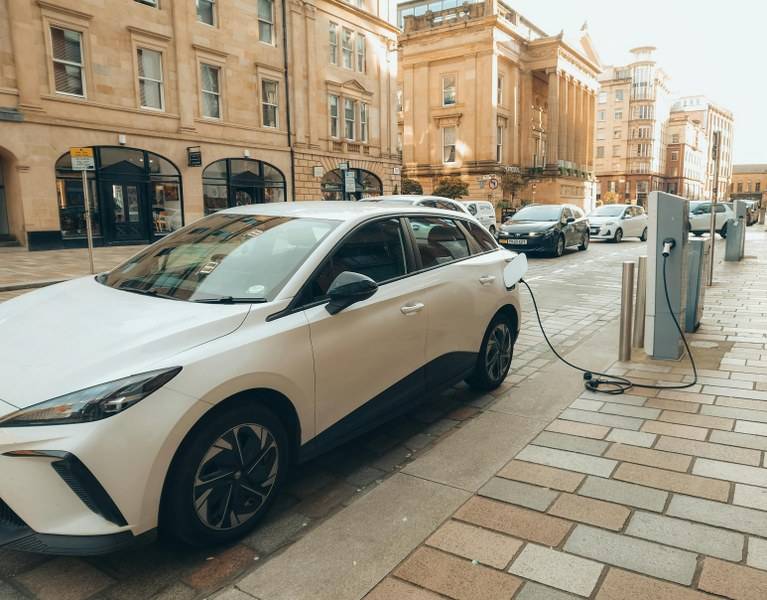How Much Oil Does It Take to Produce an Electric Car?

We all love the idea of electric cars, don’t we? They’re sleek, quiet, and whisper to the world, “I care about the planet.” But behind those silent motors and futuristic dashboards lies a truth that’s not so… electric. Have you ever wondered, how much oil does it take to produce an electric car?
It’s one of those questions that rarely makes the headlines, yet it reveals so much about the real impact of our tech-driven choices. It’s not just about plugging in your car instead of filling up a tank. The production process—mining, transporting, assembling—still relies heavily on oil. And this is where the narrative gets interesting.
Let’s take a friendly but honest stroll into the real-world numbers, emotions, and contradictions hiding behind that shiny EV in your neighbor’s driveway.
The Dream vs. The Dirty Truth
We picture electric vehicles (EVs) as the clean, green, and guilt-free way forward. No tailpipe emissions. No gas stations. Just a smooth ride on renewable dreams.
But hold up—how much oil does it take to produce an electric car, really?
Turns out, making an EV still takes a surprising amount of fossil fuels. Why? Because oil is used in every single step: from mining lithium to making plastic for the seats. It’s like going vegan, but still wearing leather shoes. The intention is good, but the execution is… complicated.
When we talk about “zero emissions,” we often forget about embodied energy—the total oil and energy used before the car even hits the road. That’s where the oil story begins. And trust me, it’s not as “clean” as we think.
Why Oil Is Still Essential in EV Manufacturing
Let’s start at the foundation. The production of an electric car includes:
Mining rare earth materials (like lithium, cobalt, nickel)
Transporting raw materials globally
Manufacturing complex battery systems
Assembly in high-energy-use factories
Making plastic, rubber, and lubricants—all oil-based
Each of these steps requires large quantities of oil, whether directly through diesel-powered machinery or indirectly through plastic and chemical production. You might be surprised, but even the solar panels and wind turbines used to charge EVs have oil behind their creation.
Let me tell you something personal. A friend of mine, super into green tech, proudly bought his first EV. When we started chatting about the lifecycle of that car, his jaw literally dropped. He had no idea oil was used at every stage, including in the shiny paint and dashboard trims.
Fun fact: Even the electric car tires use synthetic rubber derived from petroleum.
Breaking It Down: Oil Inputs in EV vs. Gasoline Cars

| Component | Electric Car (EV) | Gasoline Car |
|---|---|---|
| Battery production | High oil consumption | None |
| Engine components | Moderate | High |
| Plastic interior parts | High | High |
| Manufacturing emissions | Higher upfront | Lower upfront |
| Total oil used (est.) | 100-150 gallons | 50-100 gallons |
Looking at the numbers, an EV can take up to 150 gallons of oil to produce, especially due to its massive lithium-ion battery. In contrast, a gasoline vehicle might use 30–40% less oil in the manufacturing process.
Shocked? You’re not alone.
The Battery Burden: A Deep Dive
Let’s talk about the elephant in the electric room: the battery.
A single EV battery can weigh over 1,000 pounds. To build one, companies need:
25 lbs of lithium
60 lbs of nickel
44 lbs of manganese
15 lbs of cobalt
Tons of graphite, copper, and aluminum
Extracting and processing these minerals? You guessed it—it takes oil. Heavy diesel machines, global shipping containers, refining chemicals—all oil-powered.
A study by Argonne National Laboratory found that just producing an EV battery can consume up to 70 gallons of oil in direct and indirect energy. That’s nearly as much oil as your gas-powered car would use in 1,500 miles of driving!
This doesn’t even count the carbon footprint of oil burned during mining operations in countries like the Democratic Republic of Congo or Chile. Sometimes, “clean” energy isn’t so clean after all.
Oil in Transportation and Assembly
Here’s something we often overlook: the journey. The raw materials for your Tesla battery don’t grow in a lab next door.
Cobalt might come from Congo
Nickel from Indonesia
Lithium from Australia
Aluminum from China
All these materials travel thousands of miles in cargo ships, trucks, and planes—all powered by oil. A typical EV might accumulate over 50,000 miles of oil-fueled transportation before it even rolls into a dealership.
And when those parts finally reach the factory? The heavy machinery, robotic arms, and paint shops run on electricity that often comes from fossil-fuel-powered grids, especially in China or India where many EVs are made.
So, how much oil does it take to produce an electric car? Easily more than 100 gallons, just counting mining, transportation, and assembly. That’s before it even gets its first charge.
Plastics, Paints, and Petrochemicals
Here’s another rabbit hole that most of us forget about—petrochemicals.
From the leather-like seats to dashboard coatings, nearly every EV is loaded with plastic-based materials. And what are plastics made of? Crude oil.
Synthetic seat fabrics? Oil.
Wire insulation? Oil.
Floor mats? Yep, oil.
Airbags and safety features? You guessed it—oil again.
EVs might not burn oil like gas cars, but they wear it, sit in it, and drive with it—literally. Some studies estimate that 20% of an EV’s components by weight come directly from oil-based materials. So even if your ride is electric, its DNA is still fossil-based.
Do EVs Eventually Offset Their Oil Use?
Here’s the silver lining: while electric vehicles consume a surprising amount of oil during production, they don’t need fuel for daily operation. That’s where the oil savings begin.
After about 15,000–20,000 miles, many EVs begin to offset the upfront oil and emissions that went into building them. Compared to a gasoline car burning through fossil fuels every week, the EV eventually “pays back” its oil debt—especially when charged on a green energy grid.
But here’s the catch: if your electricity still comes from coal or gas plants, that EV might not be as eco-friendly as you think. In countries like Norway, where electricity is 98% renewable, EVs shine. In places where fossil fuels dominate the grid, the offset takes longer—or doesn’t happen at all.
So yes, how much oil does it take to produce an electric car is a valid concern, but the story isn’t black and white. It depends heavily on how and where that EV is used and charged.
The Renewable Energy Angle: Is It Enough?
People often say, “It’s okay, renewables will take care of it.” But even wind turbines, solar panels, and hydro systems have oil footprints.
Here’s a mind-bending fact: the construction of a wind turbine uses around 4,000 liters (1,000 gallons) of oil, mainly for steel production, transport, and installation. Solar panels require mining of silicon, silver, and rare metals—again, needing oil-powered processes.
And since the EV industry is growing fast, we need more charging stations, battery plants, and infrastructure—which all currently run on traditional energy inputs, including oil.
So while renewables are part of the long-term solution, they’re not an instant escape hatch from oil. Not yet.
Comparing Lifespan Oil Use: EVs vs Gasoline Cars
Let’s break it down simply.
| Factor | Electric Car (EV) | Gasoline Car |
|---|---|---|
| Oil in manufacturing | High (100–150 gallons) | Medium (50–100 gallons) |
| Oil in operation (10 years) | Low (indirect only) | Very high (3,000+ gallons) |
| Maintenance oil consumption | Low (no engine oil needed) | High (frequent oil changes) |
| Net oil usage over lifetime | Significantly lower | Much higher |
This table shows the trade-off: EVs use more oil at the beginning, but much less over time. If the car lasts over 150,000 miles, its overall oil footprint becomes much smaller than its gas-powered cousins.
Ethical Questions: Are We Just Outsourcing the Problem?
Here’s a raw truth. Much of the oil and energy used to make EVs is burned far away—in countries with lower environmental standards. So, while we drive “clean” in California or Copenhagen, the oil and pollution happen in Congo, China, or Chile.
This disconnect can feel a bit like greenwashing. It’s one of those moments where being informed can feel both empowering and uncomfortable. But awareness is the first step to better choices.
When we ask, how much oil does it take to produce an electric car, we’re also asking: Who pays the environmental price? Who benefits? And how can we do better?
Can Technology Reduce Oil in EV Production?
Thankfully, the industry is working on it. Several companies are:
Building solid-state batteries that require fewer rare materials
Using recycled plastics for interiors
Powering factories with solar or wind energy
Exploring local sourcing to reduce global shipping oil use
For example, Tesla’s Gigafactories aim to be energy-efficient and partially solar-powered. BMW has partnered with green aluminum suppliers. Ford is investing in US-based lithium projects to cut shipping distances.
These steps won’t make EVs oil-free overnight, but they can reduce the footprint significantly over the next decade.
Solutions: How to Drive Cleaner and Smarter
If you’re planning to buy or already own an EV, here’s how you can reduce your oil impact:
Charge with clean energy if possible—use solar at home or choose green utility options.
Extend your vehicle’s life. The longer you drive it, the more you offset production oil.
Buy used or refurbished EVs. Second-hand means zero new manufacturing oil.
Support brands with cleaner supply chains.
Advocate for local manufacturing to reduce shipping oil.
Small steps, yes. But they add up—especially when multiplied by millions of drivers.
FAQs: Quick Answers for Curious Minds
1. How much oil is used to make a Tesla Model 3?
About 120 to 150 gallons of oil, considering its battery size, materials, and global manufacturing.
2. Do EVs completely eliminate the need for oil?
No. While they don’t burn oil to operate, their production still depends on oil-based materials and energy.
3. Is a hybrid car better in terms of oil use?
Hybrids use slightly less oil than EVs in production but still rely on fuel during use, making their total oil footprint similar over time.
4. Will future EVs use less oil?
Yes. As technology improves and factories go green, the oil footprint is expected to shrink.
5. What part of EV production uses the most oil?
The battery. Mining, refining, and assembling it takes more oil than any other component.
6. Is charging an EV oil-free?
It depends on your electricity source. If your grid uses oil, coal, or gas, your EV indirectly uses oil too.
7. Can recycling EV parts reduce oil usage?
Absolutely. Recycling reduces the need for fresh material extraction, saving both oil and emissions.
8. Should I still buy an EV?
If you can charge cleanly and drive long-term, yes. Just be mindful and support greener brands.
Final Thoughts: The Truth Beneath the Hood
So, how much oil does it take to produce an electric car? Roughly 100 to 150 gallons, depending on size, materials, and sourcing. That’s more than a gasoline car at the start—but far less over time if used efficiently.
Here’s the emotional part: electric cars are not perfect, but they are part of a larger, evolving solution. They represent progress—not perfection. If we’re aware of their hidden costs, we can push for cleaner production, smarter energy use, and more sustainable driving habits.
It’s okay to be excited about EVs—but let’s stay grounded too. Like all good things in life, they come with responsibility.






